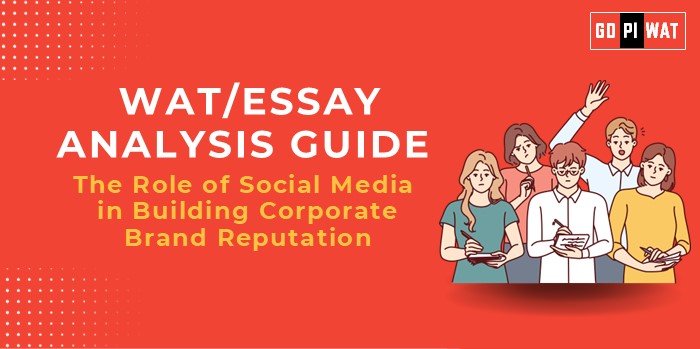📋 WAT/Essay Analysis Guide
🌟 Topic: The Role of Social Media in Building Corporate Brand Reputation
🌐 Understanding the Topic’s Importance
Social media is no longer just a tool—it’s a critical driver of brand communication, influencing customer perceptions, trust, and purchasing decisions. It connects with broader themes of digital marketing, crisis management, and consumer behavior—key to management studies.
📑 Effective Planning and Writing
- Time Allocation (30 minutes):
- Planning: 5 minutes
- Writing: 20 minutes
- Review: 5 minutes
- Preparation Tips:
- Use recent data (e.g., user trends, case studies).
- Highlight both opportunities and risks.
📝 Introduction Techniques for Essays
- Contrast Approach: “While social media provides unprecedented opportunities for brand communication, it also poses significant challenges like misinformation and backlash.”
- Case-Based Approach: “When Starbucks’ #RedCupControversy went viral, the brand’s response demonstrated the power of social media to turn crises into opportunities.”
- Statistical Start: “With over 5 billion users globally, social media has become the most powerful tool for corporate brand building.”
📊 Structuring the Essay Body
- Achievements:
- Real-time engagement boosts customer satisfaction.
- Successful campaigns (e.g., Nike’s “Believe in Something” ad featuring Colin Kaepernick) enhance brand trust.
- Challenges with Comparative Analysis:
- Viral backlash examples: Pepsi’s Kendall Jenner ad faced massive criticism.
- Solutions: Timely communication and ethical advertising practices.
- Future Outlook:
- Growing use of AI in content targeting.
- Rising focus on data security and personalized marketing.
📌 Concluding Effectively
- Balanced Conclusion: “While social media enables companies to build brand loyalty effectively, mitigating risks of misinformation and privacy concerns is crucial to sustaining success.”
- Future-Focused Conclusion: “As social media evolves, companies must balance innovation with responsibility to build a sustainable, trusted brand reputation.”
🔍 Analyzing Successes and Shortcomings
- Key Achievements:
- Cost-effective global branding.
- Real-time customer engagement.
- Ongoing Challenges:
- Privacy breaches erode trust.
- Viral crises escalate quickly.
- Global Context:
- U.S. brands excel in humor and creativity (e.g., Wendy’s).
- Asia leverages video-based engagement (e.g., TikTok’s role in branding).
🔧 Recommendations for Sustainable Progress
- Adopt Proactive Reputation Management: Monitor feedback using AI-driven analytics.
- Prioritize Ethical Communication: Ensure transparency in campaigns and ads.
- Focus on Data Privacy: Build consumer trust by safeguarding user information.
✍️ Sample Short Essays on The Topic
- Balanced Perspective (100 words): “Social media has redefined corporate branding by enabling cost-effective, real-time communication. Brands like Nike and Coca-Cola leverage platforms to engage consumers globally. However, it also poses risks—Pepsi’s failed campaign and viral controversies show the fragility of reputation. A balanced approach, combining proactive management and transparency, is key to leveraging social media effectively.”
- Solution-Oriented Approach (100 words): “Social media empowers brands to connect with customers instantly. Yet, privacy concerns and viral backlash challenge its reliability. To sustain reputation, companies should adopt AI tools for monitoring sentiment, maintain ethical messaging, and address issues promptly. Implementing robust privacy measures will further build trust in the digital age.”
- Global Comparison (100 words): “U.S. companies excel in leveraging humor on social media, while Asia leads with engaging short-form video content. Brands like Wendy’s (U.S.) and Samsung (Korea) showcase how localized strategies can enhance reputation. Social media’s future success for corporates lies in adopting platform-specific approaches and prioritizing ethical, user-centric content.”


